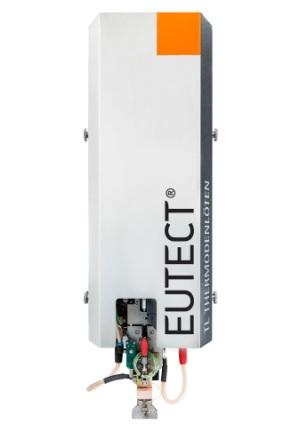First µ-precise Penetration during Thermode Soldering
As Eutect put the first force- and temperature-controlled thermode soldering module into operation at an international headlamp manufacturer in 2005, the measurement of the penetration of the thermode was used exclusively as process monitoring and -control. A lot has happened since then. In 2018, Eutect completed the next further development of the thermode soldering module, which thanks to freely definable parameters, offers new process opportunities.
"A present-day force- and temperature-controlled thermode soldering module must be able to do more than just monitor a process", declared Matthias Fehrenbach, CEO of Eutect GmbH. Since the completion of the last further development of the particular module, all process-relevant parameters can be defined. "This refers in particular to the contact pressure, penetration depth and the temperature profile, which for the first time can now be defined exactly for the process and the needs of the operator. We thereby offer the user far more than a controlled and monitored process. He gets a 100% coordinated and definable process", elaborated Fehrenbach. These further developments lead to the capability of optimising the cycle time.
The contact pressure of the thermode is 1-60 N. The contact force is displayed and regulated in steps of 0.5 N. This contact pressure can be input via the new visual controller view, according to application and material. A leading and follow-on hold-down device fixes the surfaces to be soldered. "By means of the application-optimised contact pressure and the hold-down devices, which are also new, we can optimise the cycle time up to 70%, depending on the heat sink of the solder points", stressed Fehrenbach. Furthermore, the penetration can be controlled. The accuracy of the penetration control is about 1µm, which is unique in the field of thermode soldering. "The penetration depth that can be freely adjusted in µ ensures a defined solder gap and therefore the most optimal intermetallic phase formation", as Fehrenbach explained the process advantages.
In addition the temperature profile can also be regulated via the new controller and controlled by means of a redundant temperature measurement. The maximum thermode temperature is 450°C. Resistance measurements for monitoring the contact surfaces are also possible. "Furthermore, we have carried out a few more mechanical adaptations", mentioned Fehrenbach. Through the use of smaller, close-fitting Kapton dispensers, it was possible to minimise the overall installation space. The working stroke can be optionally increased up to 50 mm.

Press Releases
- Innominds and SIIX launch SIIX-Innominds JV to offer full-stack ODM services in India
- Syrma SGS Technology, Ltd to Accelerate AI-Driven Manufacturing with implementation of analytics and AI solution from Arch Systems in partnership with NMTronics India
- TTCI and The Training Connection Strengthen Electronics Manufacturing with Test Services and Training at PCB West 2025
- SMTA “Members of Distinction” Awards Announced







